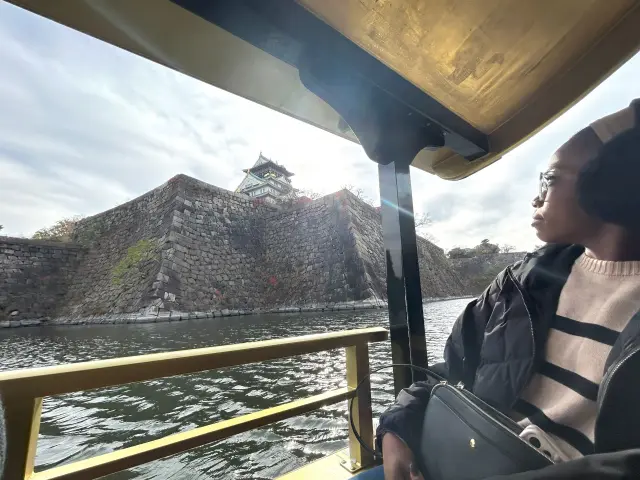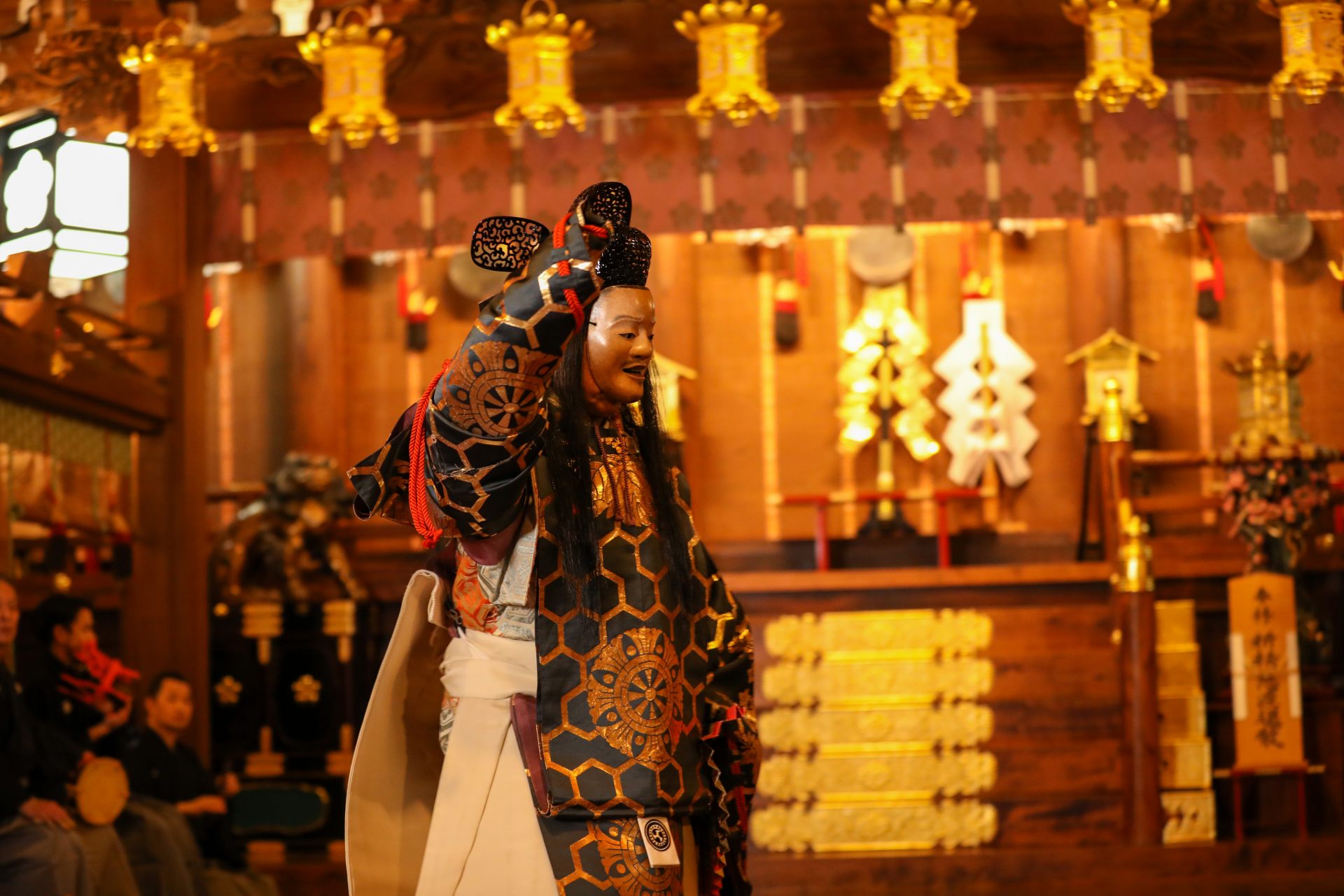
Luxury Travel Diary: Exquisite and unforgettable experience in Osaka
Last update
A city of immense history dating back to the 5th century, Osaka was the gateway to Japan for many merchants and travelers across East Asia and remains an important cultural and economic center of Japan. As a gathering point for learning, technology, and commerce, Osaka has evolved over centuries and continues to take the lead on many aspects of contemporary Japan.
Osaka is often described as Japan’s pleasure capital, diverging from the often strict and measured rules elsewhere, that while polite, can be a bit stiff at times. This elegant and at times extravagant trip itinerary was created to explore the true culture of Osaka and find out what makes it such an interesting and unforgettable destination.
Throughout the journey, we explore elegance, diversity, and individuality through tailored, luxurious experiences focusing on culture, history, and food.
Be put in touch with the enduring merchant culture on Japan’s longest shopping street
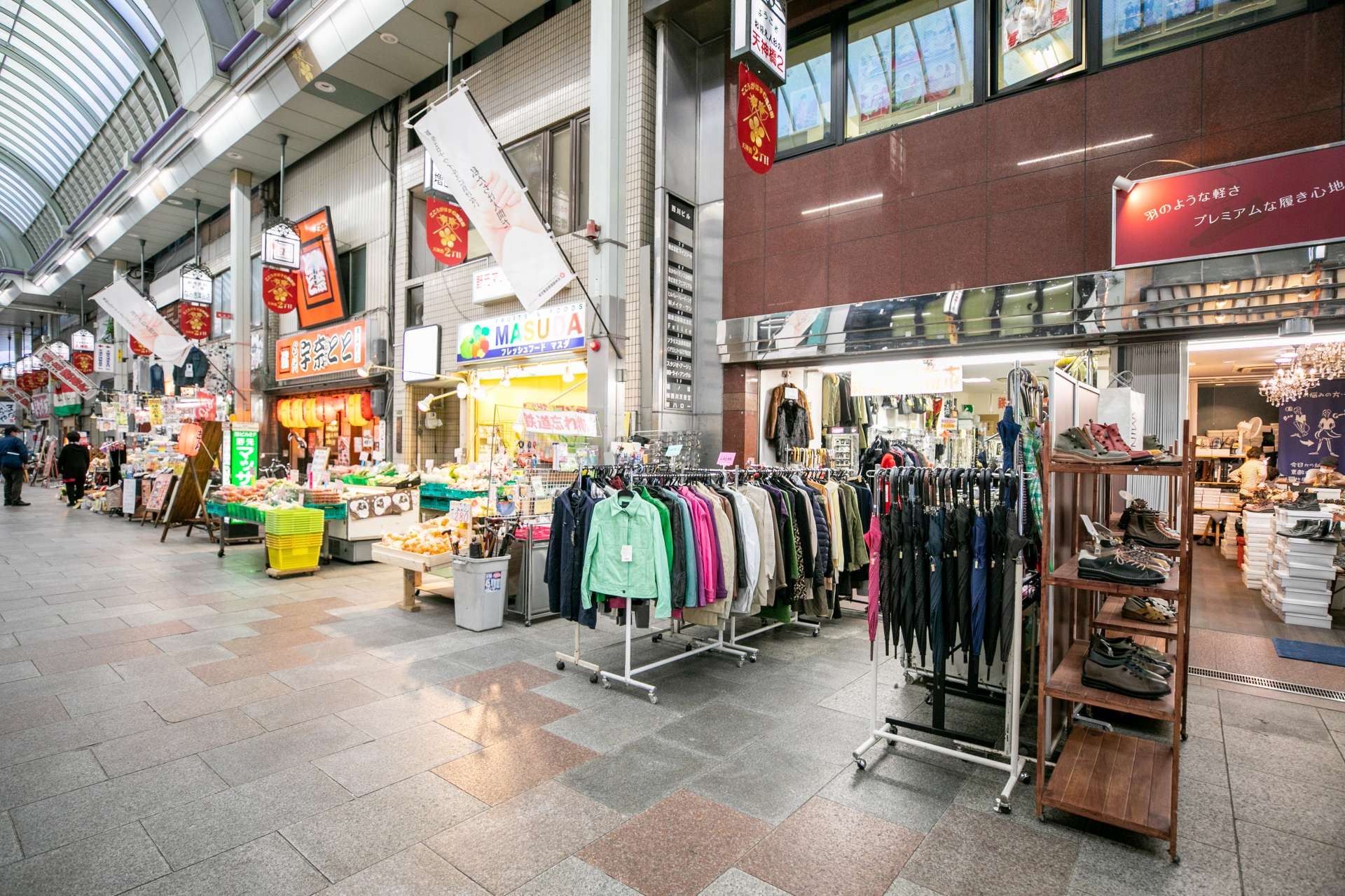
A wide variety of stores dedicated to clothing, food, and household essentials.
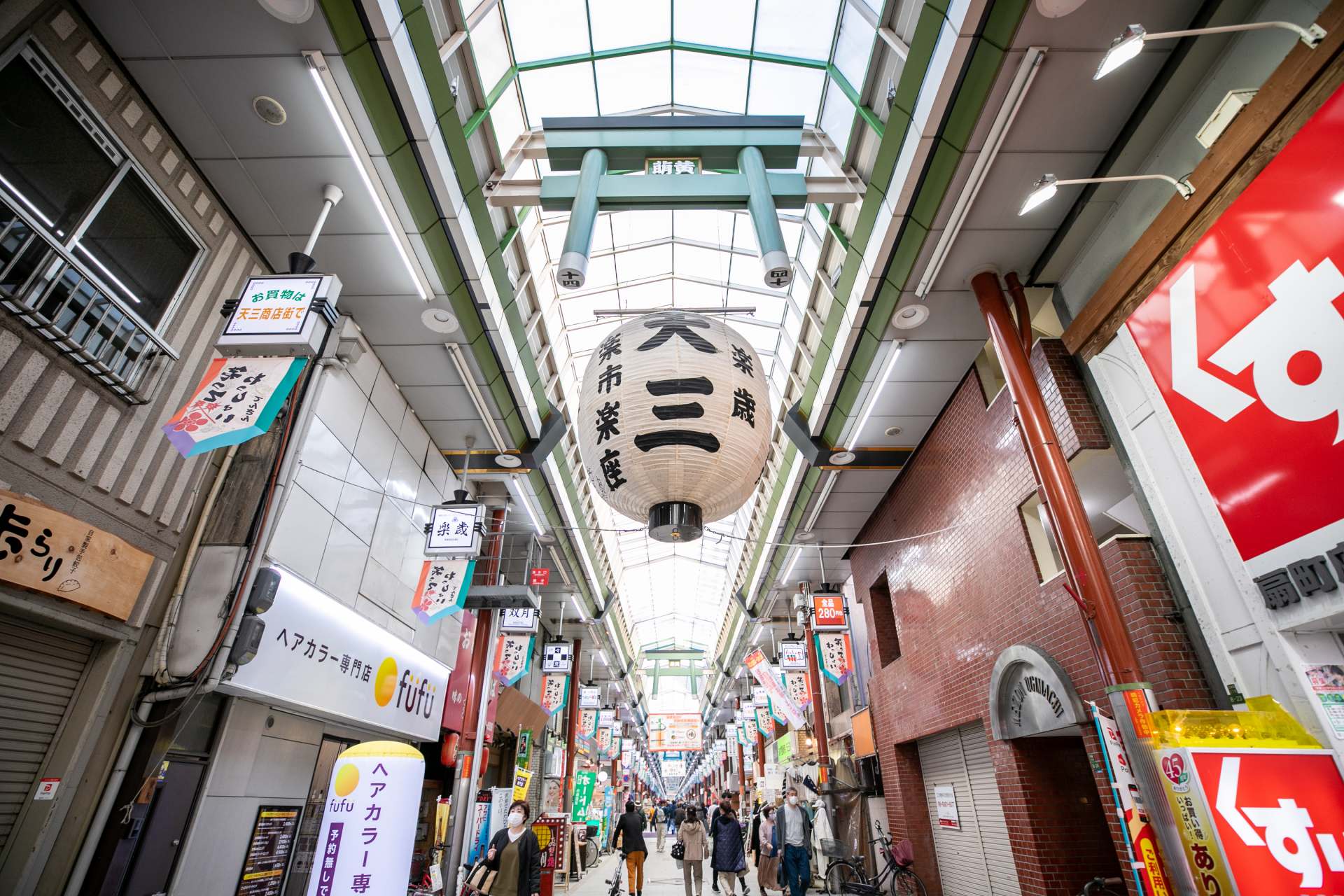
An enclosed arcade design reveals the roots of the street’s prosperity, while the torii gates and lanterns overhead signify the street as the gate to Osaka Temmangu Shrine.
The journey starts 20 minutes south of Shin-Osaka Station, the hub of sightseeing in Osaka, as we traverse Tenjinbashisuji Shopping Street. Next to a large park, you can find the street entrance easily by the enormous arches and the rows of torii gates high above.
There are many shopping streets in the commercial city of Osaka but this one is nothing less than exceptional by any standard. Tenjinbashisuji is the longest shopping street in Japan boasting around 800 shops and stretching for more than 2.6km from north to south. The street grew to prosperity due to its proximity to Osaka Temmangu Shrine in the Edo period (1603-1867) as travelers needed places to shop, rest, and eat along the way.
Walking through the bustling streets is an occasionally overwhelming experience as there is no shortage of unique shops in all directions filled with clothing, ready-to-eat food, and household good, as well as high-end items such as Japanese cooking knives, kimono, and fine pottery and ceramics.
Each storefront is a scene where shop owners and customers enjoy small talk and banter giving it a rustic feel despite its urban location. Looking around, we can understand Osaka culture and its people who value real relationships and communication over a quick sale. Each store is viewed as a part of the greater community, not just a place to buy and sell products. That being said, they are also more than happy to discuss their wares in detail and answer any questions you may have.
Long before you have reached the end of the street you will have become one of the locals and experienced the warmth and culture of Osaka. Needless to say, you may well have picked up a great deal to remember your time spent in Osaka.
Spiritual refreshment at Osaka Temmangu Shrine
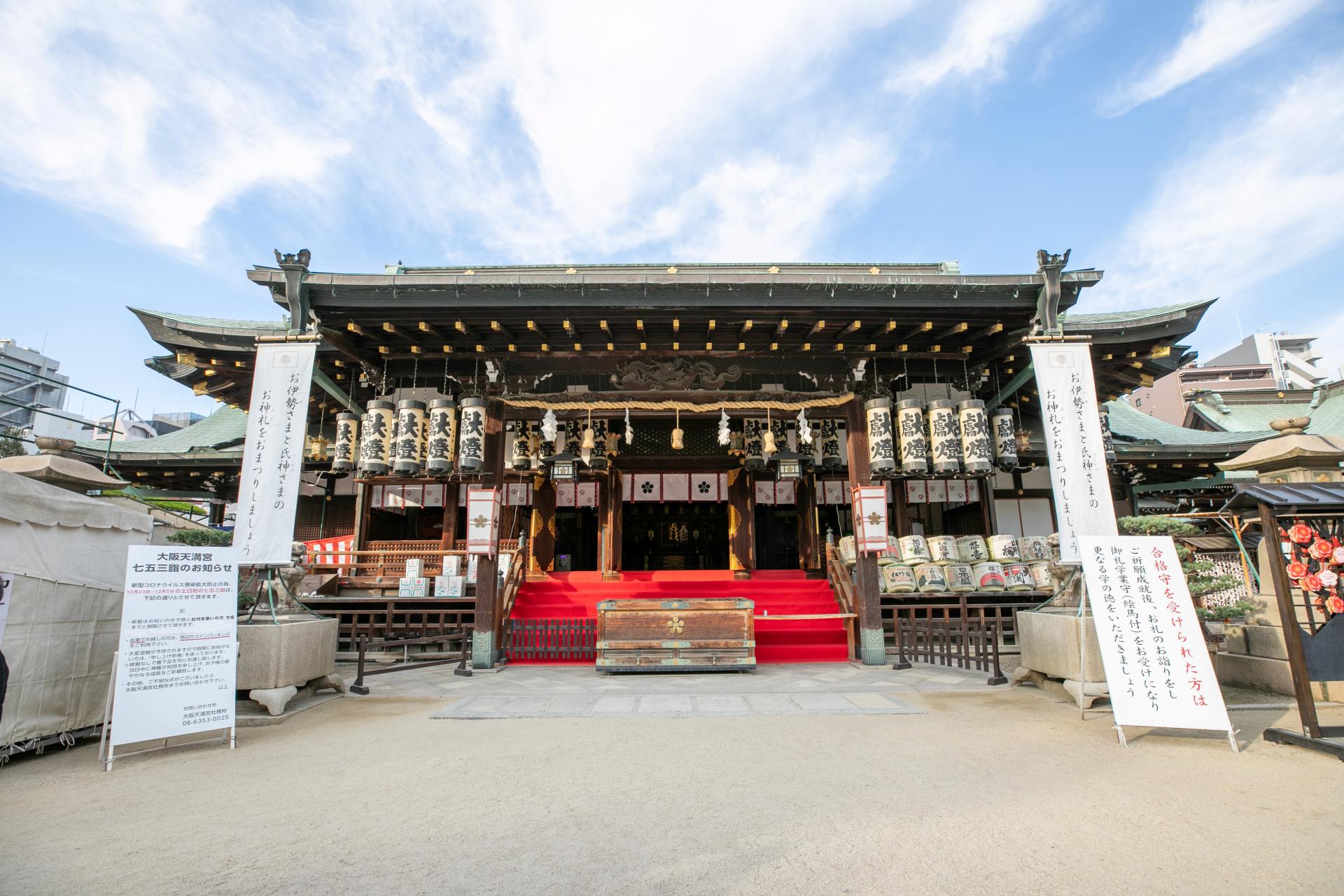
The main building of Osaka Temmangu Shrine is one of the largest wooden buildings in Osaka Prefecture.
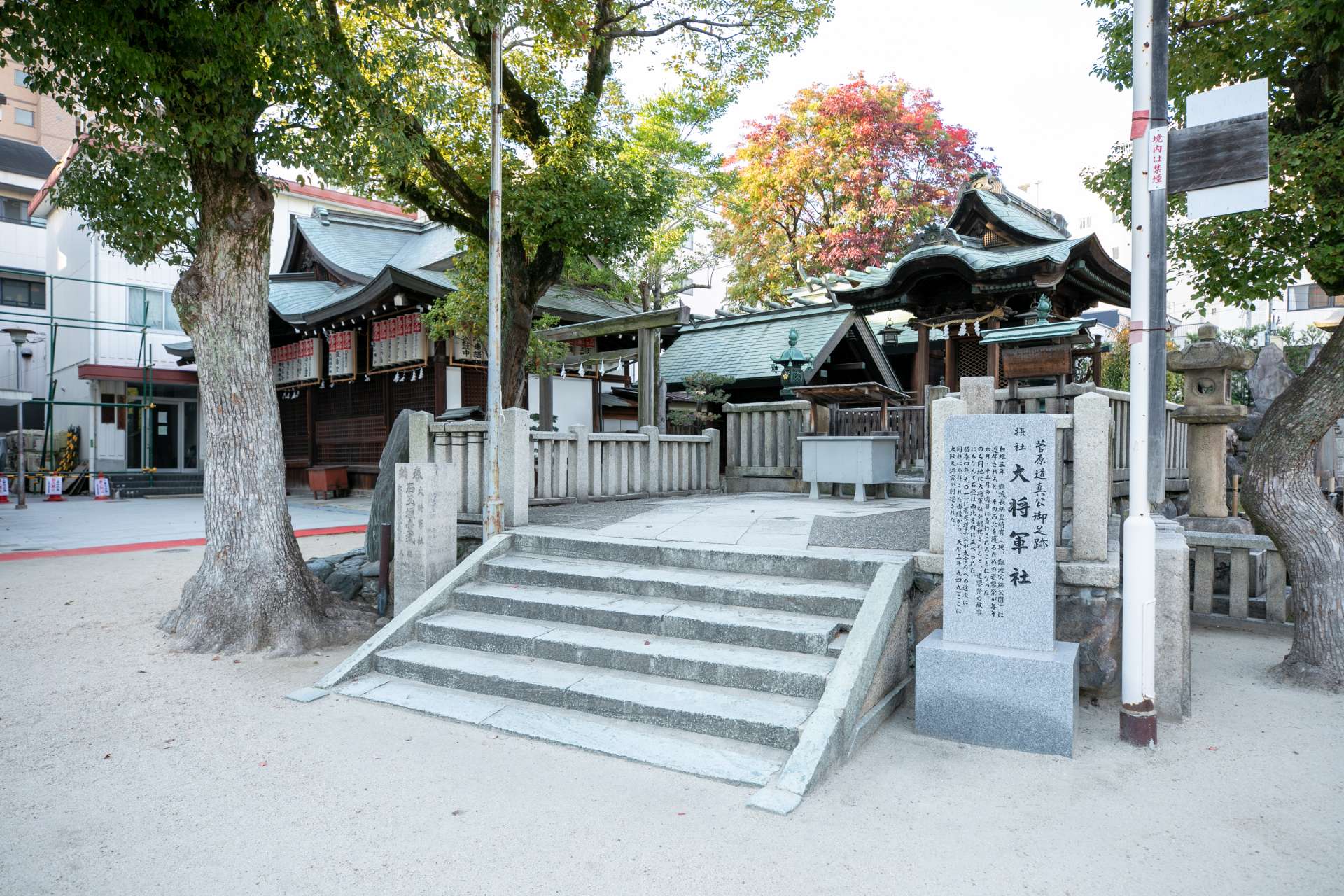
Daishogun Shrine also located on the grounds, and this is where the scholar and poet Sugawara no Michizane famously prayed for safety after a power struggle in the Imperial Court.
After walking the length of Tenjinbashisuji Shopping Street, we emerge at the southern entrance of Osaka Temmangu Shrine. Store away any shopping bags at a nearby locker or private car and head to the attractive shrine grounds, the perfect location to rest and relax body and soul.
We have a truly special experience here in an exclusive performance of Japanese Noh Theater from some of Osaka's leading Noh performers for those lucky enough to receive an invitation, but we will get to that soon.
Before the performance, it is therapeutic to walk the shrine grounds and cleanse your mind and body through a cleansing ritual known as temizuya. Visitors perform a set of traditional gestures by bowing twice, clapping twice, and bowing again as is expected when entering a Shinto shrine.
In the Main Shrine rest five pillars, each one representing a deified individual, including Sugawara no Michizane, a famous poet and scholar also known as "Tenjin-san”. Michizane was enshrined here and became a patron god after his passing. The legend has it that upon his death seven pine trees sprung up overnight in front of Daishogun Shrine, a smaller shrine within the grounds and a place where Michizane stopped and prayed over 1,000 years ago. Michizane was deified and recognized as a patron of learning and the performing arts which is one of the reasons that traditional Noh performances are so special to this shrine.
An unforgettable and majestic Noh performance
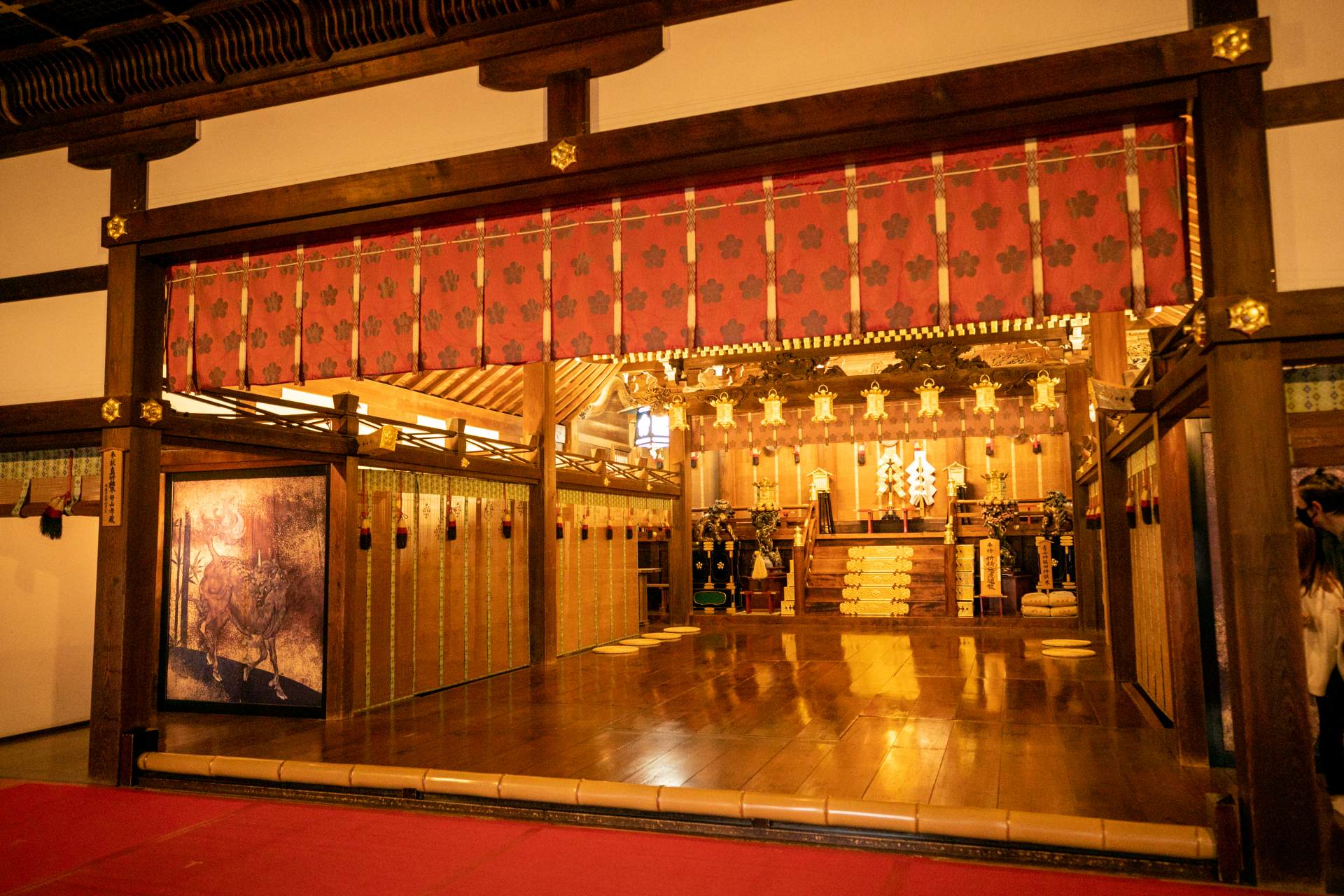
The main shrine building has an exquisite and sacred atmosphere. Beyond the low bamboo partition is the stage where Noh performers will present the private performance.
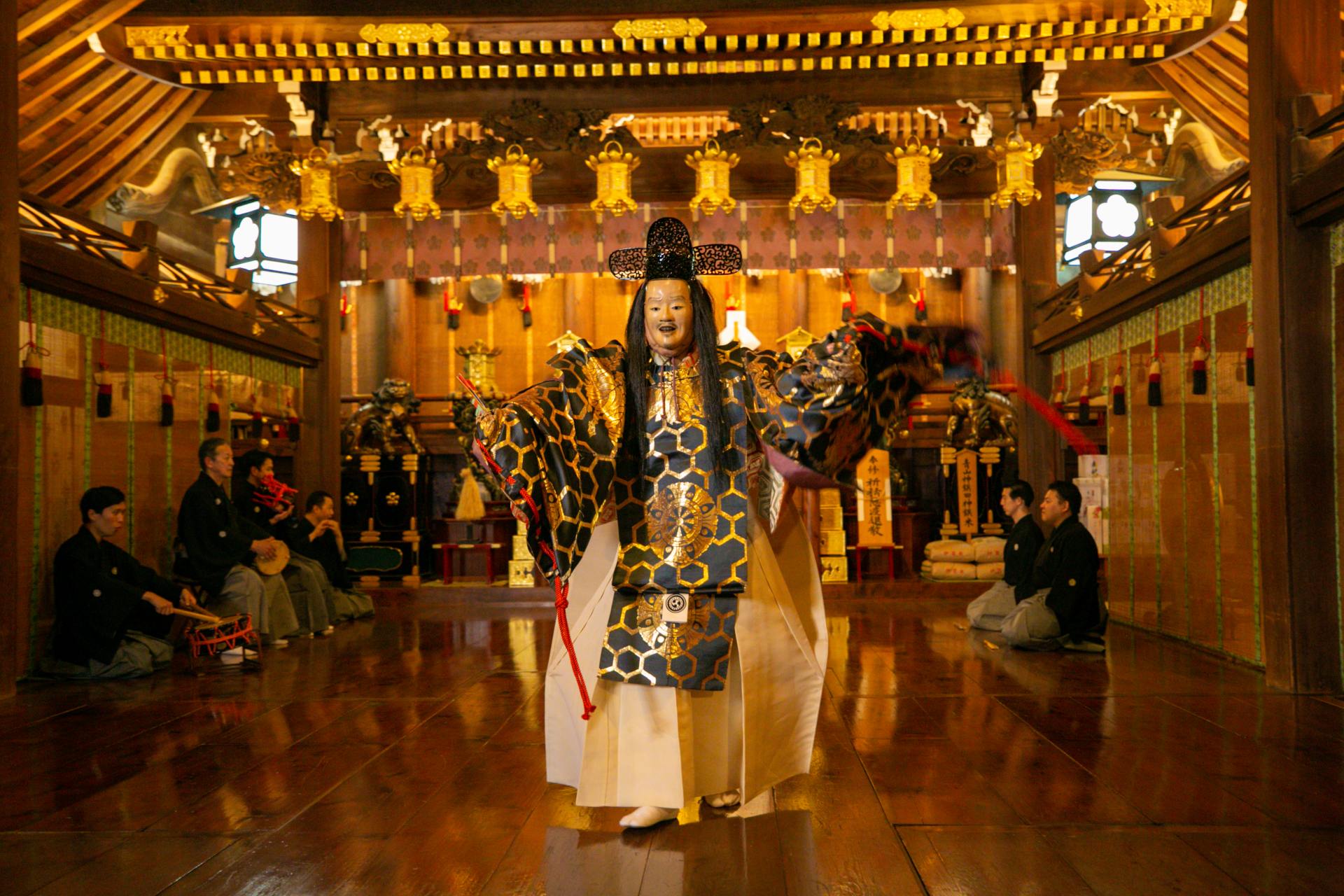
The performance is led by members of the Ueno family, one of the most important names in Noh theater.
As the shrine closes and is plunged into darkness, those invited to the special Noh performance are guided to the main building of the shrine by the head priest. Here the lucky few can see performers who have fine-tuned their craft for decades dressed in full apparel on an unimaginable stage set directly inside the shrine.
The sanctum is not normally open to the public as this is where Shinto rituals and dedication events are held. Priests and attendants dressed in shrine robes help the audience to their seats and from within the sanctum, it is possible to see the intricate ceilings, walls, and altars of the shrine in remarkable detail. After a few moments of silence in the hall of worship, Osaka's leading Noh performer, Tomoyoshi Ueno, and a group of performers and musicians take the stage. Guests who arrive early may have the chance to speak with the performers in advance and witness the dressing process and the omote mask adornment of the lead actor to complete the experience.
After the performers are in place, the Noh performance of "Takasago" begins with the first steps of the protagonist played by Tomoyoshi Ueno, a lauded actor certified as an Important Intangible Cultural Property of Japan in his own right. Tomoyoshi Ueno performs the chants and intricate dances while his son takes the lead on the musical accompaniment in a small team of seven. Viewers are sure to be captivated by the majestic and painstakingly practiced movements and dynamic accompaniment. This is a truly powerful and transcended performance worthy of one of Osaka’s most important shrines and the revered deities enshrined within.
The quiet of the shrine grounds once the performance ends provide a contemplative experience, and it is hard to imagine a more appropriate stage for the world of Noh theater.
A spiritual retreat that satisfies all the senses at the Mino-o Forest Inn
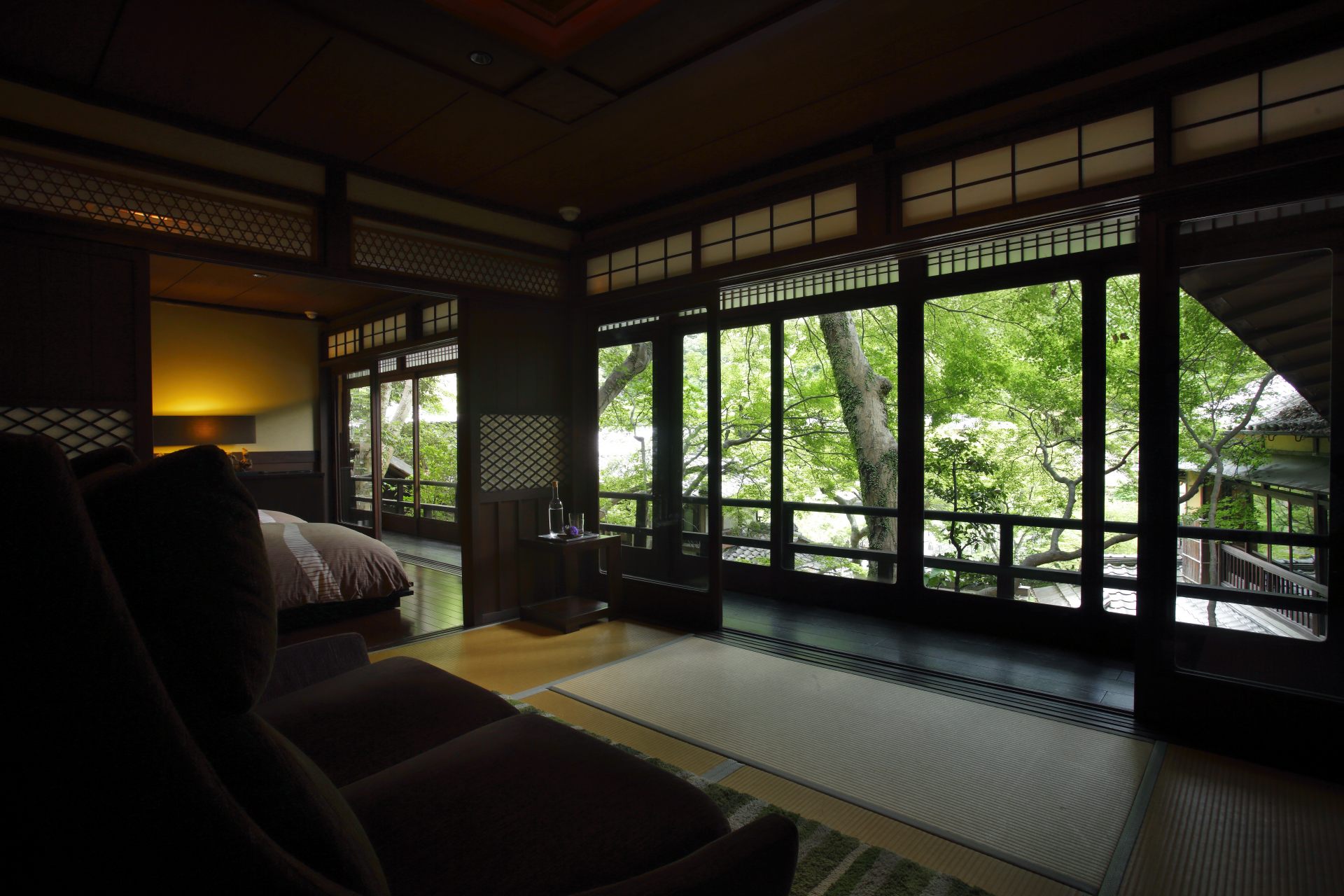
From your private room, view the natural greenery of curated gardens through the Taisho period (1912-1926) glass windows.
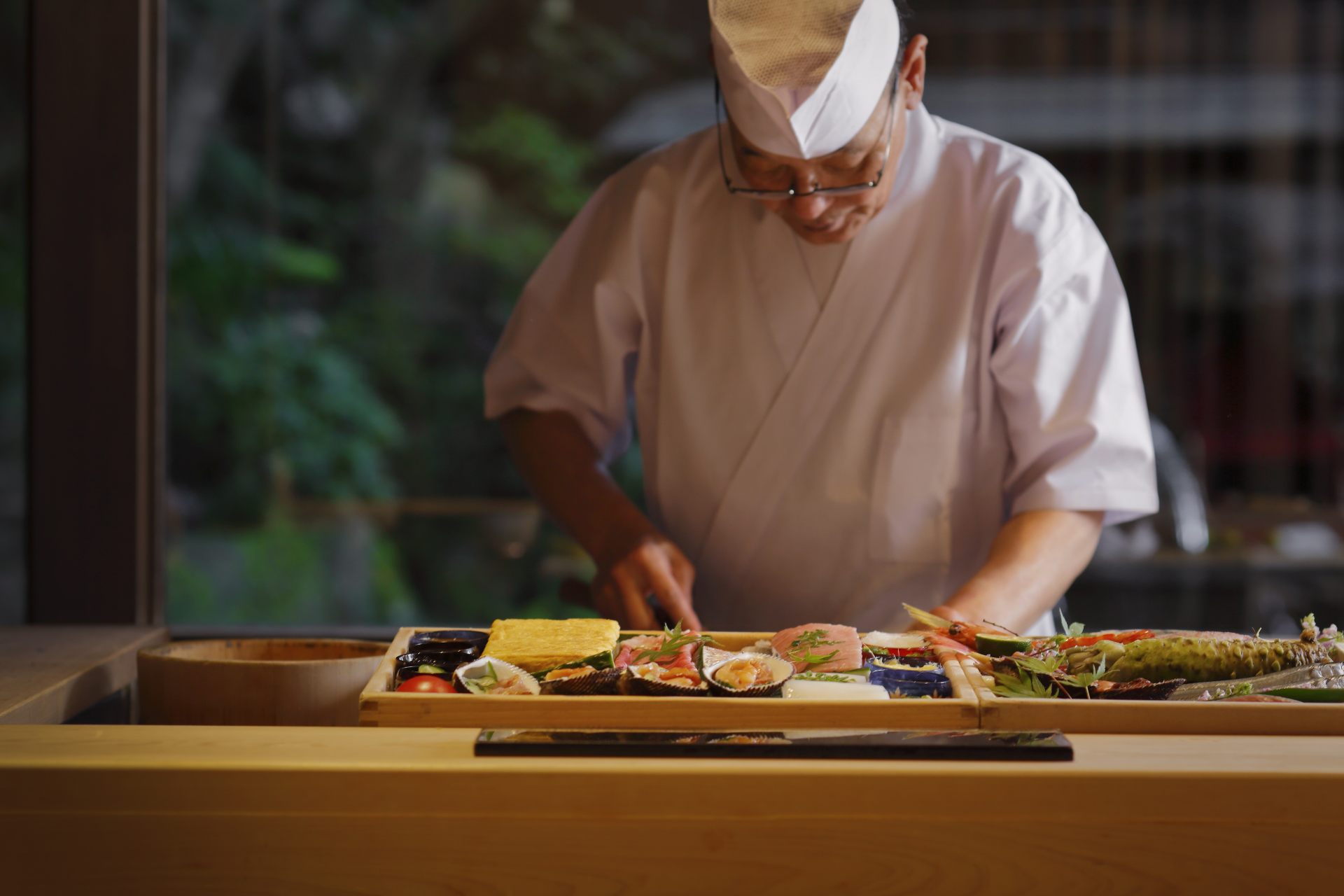
For dinner, partake in the finest sushi, where a skilled chef wields their skills right in front of your eyes.
The silence of nightfall and the drive to our next location provide time to reflect and appreciate the immersive Noh experience. Around 30 minutes by car, we next arrive at Otowa Sansou, a traditional inn set within the Meiji no Mori Mino-o Quasi-National Park located in Northern Osaka.
The inn was built in 1926 and the Japanese architecture and natural scenery are a breathtaking contrast to the urban areas explored earlier in the day. The courtyard incorporates natural rock surfaces and perfectly curated trees and gardens. The lounge is filled with distinctive artworks and piles of books and guests may partake in a cup of homemade roasted coffee that the proprietress presents as she guides you through check-in and walks you through the grounds to your rooms.
After arriving in your private rooms, be sure to take a look outside the windows from the living room and bedroom. Special rooms such as the "Mori no Uta” provide impressive views of the courtyard and the surrounding forests. The glass windows were made in the Taisho period (1912-1926) and the subtly warped vintage glass make the external views look especially otherworldly and relaxing.
Dinner is served in a dedicated dining room with its own shiraki sushi counter where skilled chefs serve and prepare sushi. The chance to view the exquisite craftsmanship of these masters up-close while indulging in intimate conversation is certain to be yet another treasured memory. Behind the sushi chefs is the backdrop of the beautiful courtyard visible beyond large windows. As each piece of sushi is presented and served with pride, the evening builds to its climax as you savor the food and the setting.
A time-honored tea ceremony and vibrant lunch in view of Osaka Castle
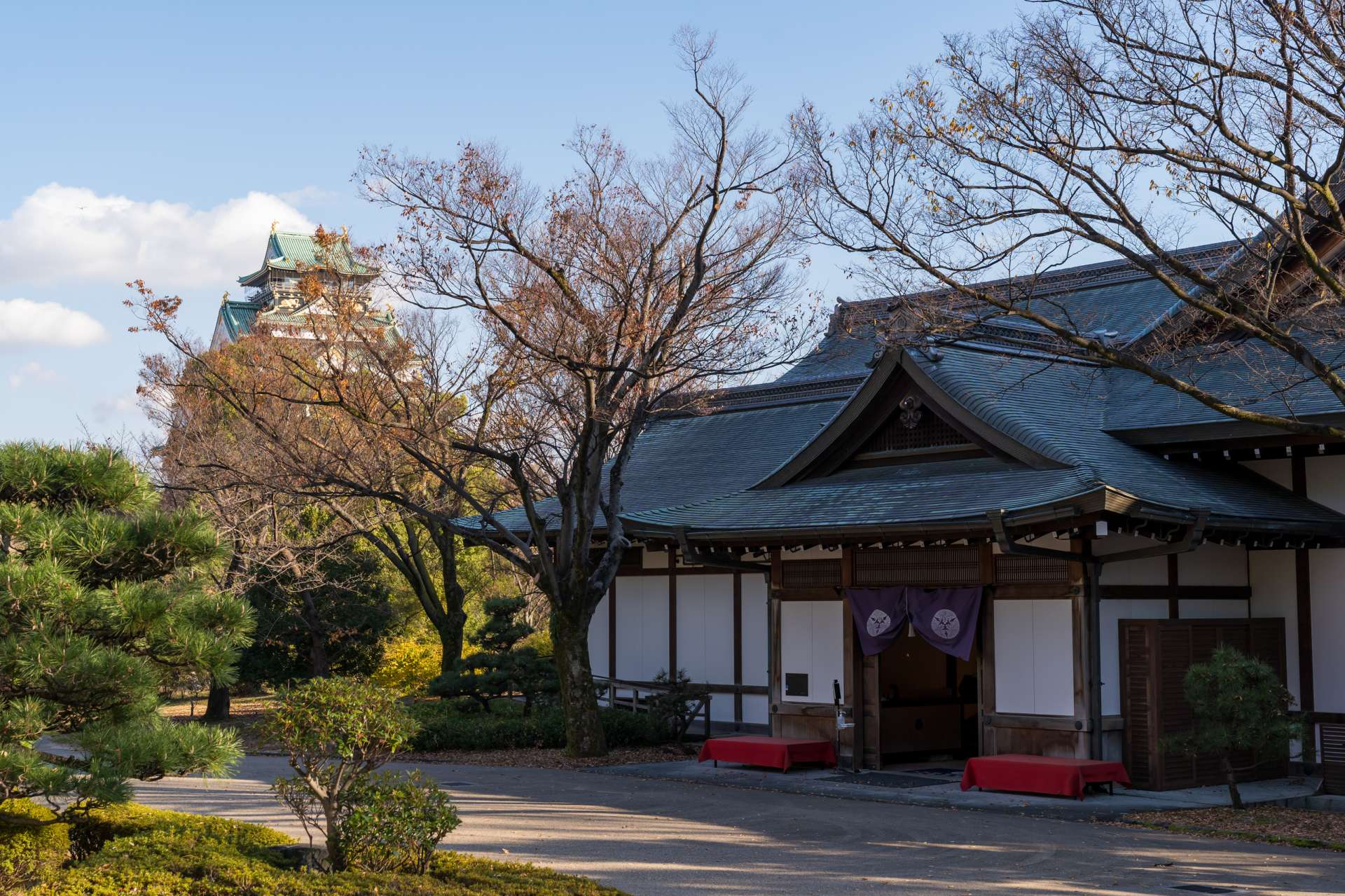
Osaka Geihinkan is a famous tea house that has welcomed world dignitaries from APEC and G20.
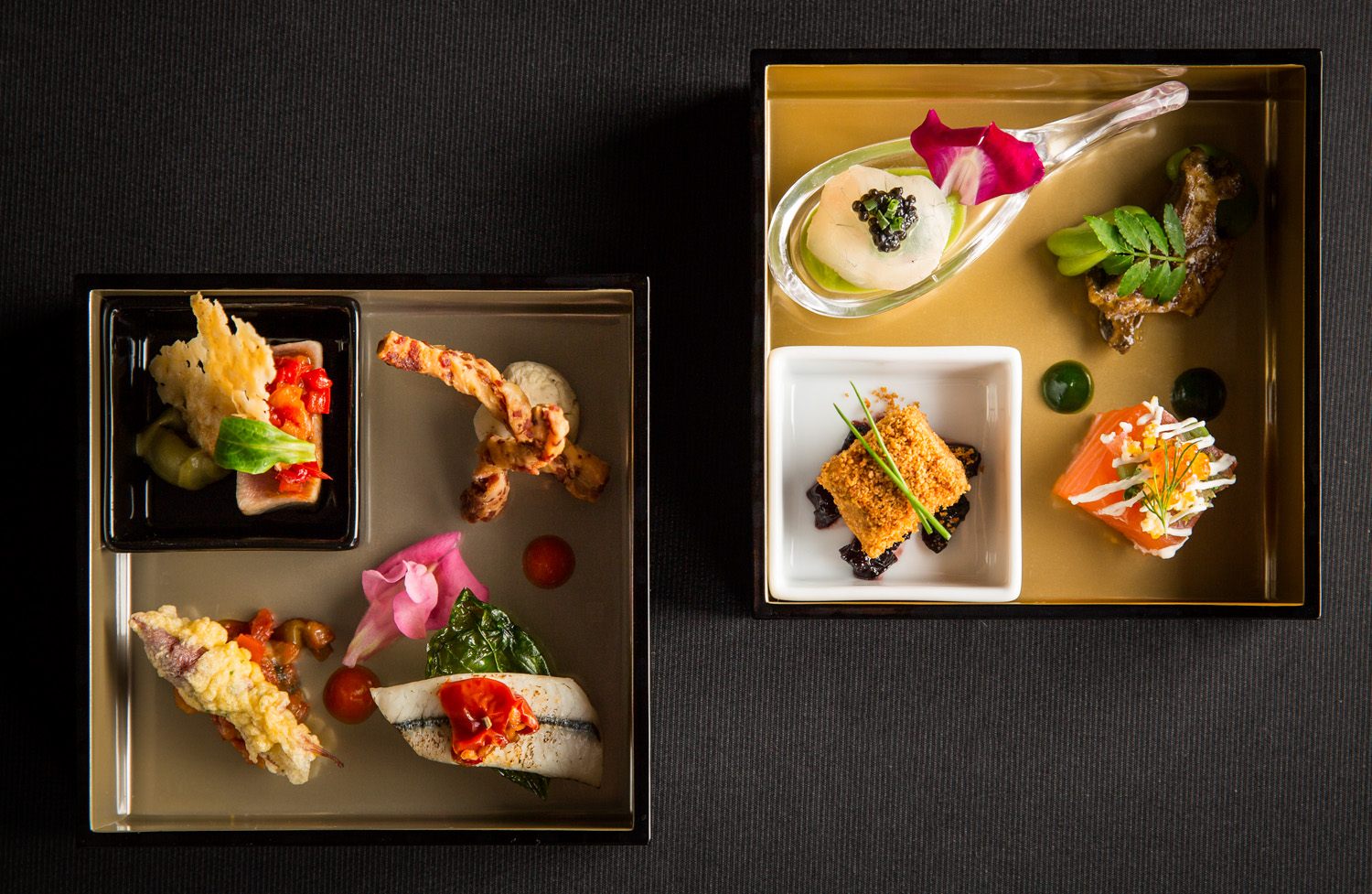
A Japanese-Western eclectic dish that is a feast for all the senses created with passion from a world-renowned chef.
The next morning in Mino-o Forest is a chance to take in the morning scenery with a walk along a celebrated river-side path to Mino-o Waterfall. After you have had your fill of the splendid falls it is time to return to Osaka once again.
The final destination of the trip is Osaka Castle, a landmark castle of Japan completed in 1568 by the then ruler of Japan, Toyotomi Hideyoshi. The majestic keep is overwhelming and gorgeous, striking out against the blue skies, and the tour moves to the Nishinomaru Garden, a sprawling Japanese garden in the corner of the castle.
Here guests can experience a tea ceremony in one of the largest tea rooms in western Japan. While looking at the castle tower through the beautiful gardens, you are served tea directly by a tea master who details the intricacies of each part of the process.
After tea, we move to the nearby Osaka Geihinkan building, created over the ruins of the main family residences of Toyotomi Hideyoshi. Lunchtime at this prestigious building has welcomed dignitaries from around the world during the 1995 APEC and 2019 G20 Osaka Summit. A special Japanese-Western course designed by Shu Ishii, a leading figure in French fusion cuisine in the Kansai region, is an unforgettable culinary experience with foods that are almost too beautiful to touch. Once tasted, however, the ingredients are sublime, and every sumptuous dish only exceeds the last. The dining room has an impressive classical interior, and every seat has views of the surrounding gardens. This is the perfect meal to end the trip in elegance and style.
Osaka's culture is experienced with all five senses through a lively shopping street, a sanctuary for the gods, the world of Noh theater, a healing forest inn, and gastronomy set in an ancient hall. The unforgettable journey represents the best of Osaka and is a mix of delicacy, sophistication, and warmth. After a trip such as this, the diversity of Osaka will not be soon forgotten.
By personally visiting Osaka and experiencing and telling about the wonderful culture and tradition we encounter there, we hope we can be some help in ensuring that charming tradition and culture of Osaka is passed down to the next generation.
Check also...

Consider your accommodation in the Kansai area!

Restrictions on Large Baggage

Hidden Stories in Stone: Exploring Japan’s Castle Walls

Feel Like a Lord: Castle with Stunning Panorama Views

Experience the True Essence of Japan through Castles, Cultural Treasures, and Timeless Gardens
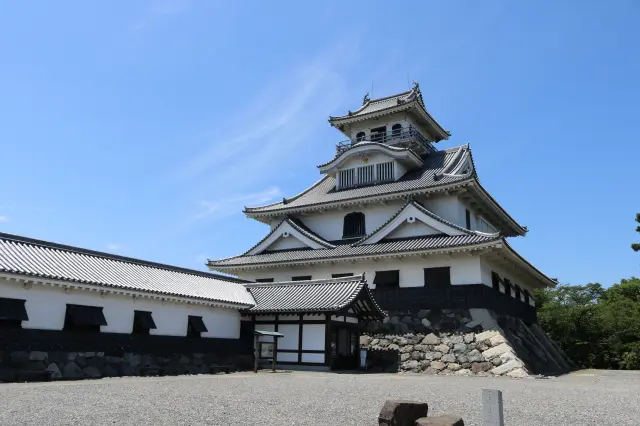
Castles of Toyotomi Hideyoshi
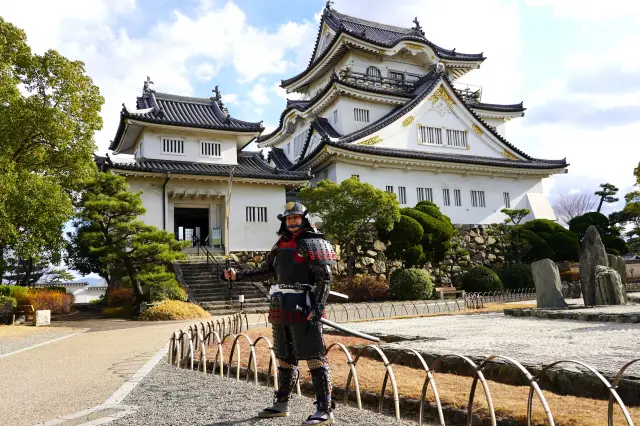
Exploring the Roots of Festivals: A Journey of Understanding Local Bonds and the Preservation of Culture
